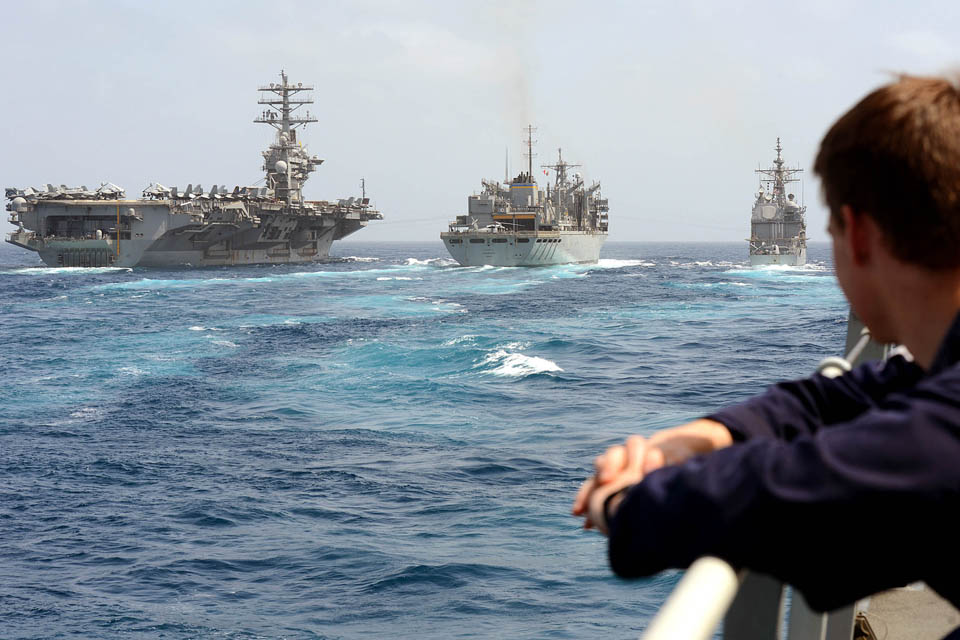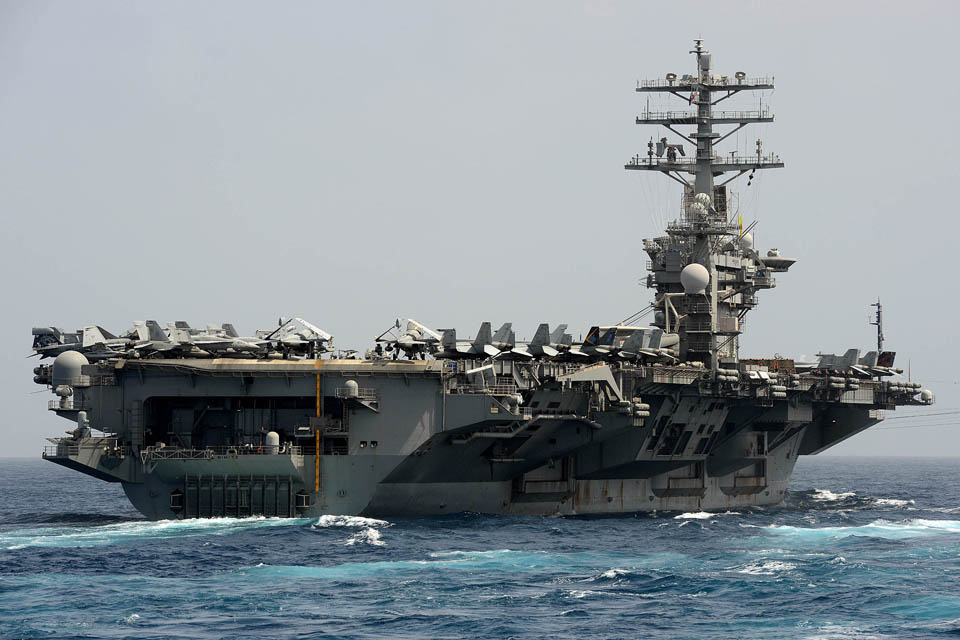HMS Dragon works with US carrier group
A Royal Navy warship has been working alongside one of the US Navy's mighty aircraft carriers in the Gulf of Oman.
![United States Marines fast-rope onto HMS Dragon's deck during an exercise [Picture: Crown copyright]](https://assets.publishing.service.gov.uk/media/5a61f16a40f0b60abc67836e/s300_IMG_8072.JPG)
United States Marines fast-rope onto HMS Dragon's deck during an exercise
The Type 45 destroyer HMS Dragon joined the USS Nimitz and her carrier battle group as they conducted maritime security operations and offered support to US forces involved in Operation Enduring Freedom.
Dragon and her ship’s company spent several days working with the battle group, providing air defence and allowing the crew to get used to operating with lots of aircraft in the vicinity.
The sheer range of aircraft encountered by the Royal Navy contingent during this period was far from usual: flying about in the skies above the ships were F/A-18E/F Super Hornets and F/A-18C Hornet strike fighters; EA-6B Prowlers, for electronic warfare; E-2C Hawkeyes, used for airborne early warning; C-2 Greyhounds, used for logistics; and a helicopter anti-submarine squadron of SH-60F and HH-60H Seahawks.

A seaman on HMS Dragon watches US naval units of Carrier Air Wing 11 replenishing at sea [Picture: Leading Airman (Photographer) Dave Jenkins, Crown copyright]
Key to making order out of this controlled aerial chaos was one of Dragon’s fighter controllers, Flying Officer David Bowl, an RAF officer embarked on Dragon for her deployment. It was his job to ensure that the skies were a safe place to be and that the carrier battle group was provided with an understanding of everything that was in the air surrounding the battle group.
He said:
Working so closely with the Nimitz and Carrier Air Wing 11 has been a superb and unique opportunity and has definitely been the highlight of my Royal Navy exchange so far.
Dragon also practised some special ship manoeuvres and set pieces that are only applicable when working with a carrier operating fast jets at sea, including acting as a ‘horizon reference’ for incoming aircraft – standing off about 4,000 yards astern of the mighty carrier and adopting a special lighting configuration to help guide pilots onto the Nimitz’s flight deck.

US Navy supercarrier USS Nimitz [Picture: Leading Airman (Photographer) Dave Jenkins, Crown copyright]
These operations provide essential experience for a new generation of sailors who will be working with new aircraft carriers HMS Queen Elizabeth and HMS Prince of Wales, which will operate F-35 Lightning II fast jets and are due to enter service in a few years’ time.
Members of Dragon’s crew also took the chance to pay a visit to the Nimitz, spending time on board and being given a taste of life on a fully-operational supercarrier as a glimpse of things to come when the Queen Elizabeth Class ships join the Royal Navy’s fleet.
Leading Seaman Rachel Thom said:
While I’ve been on an American carrier before [USS Harry S Truman in 2008] this was a much better experience.
We saw aircraft taking off and landing whilst we were on the flight deck and the air and ground crew made it look very easy. Memorable things for me were the size of the ship, just huge, and the noise, even with ear defenders on the sound of an aircraft taking off and landing was tremendous.
HMS Dragon will now return to the Gulf to continue maintaining Britain’s interests in the region. There, she will work closely with Gulf Cooperation Council members to develop an understanding of the intricate patterns of life in this complex region.